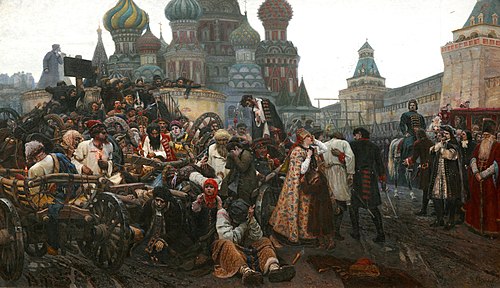Vasily Surikov
Vasily Surikov | |
|---|---|
| Awards | Four Silver Medals |
| Patron(s) | Pavel Tretyakov |
Vasily Ivanovich Surikov (
Biography
He was born to an old
In 1859, his father died of
In 1868, he rode on horseback to Saint Petersburg but was unable to qualify for admission to the Imperial Academy of Arts, so he studied at the drawing school of the Imperial Society for the Encouragement of the Arts.[2] After a year there, he was allowed to audit classes at the academy and became a full-time pupil toward the end of 1869.
From 1869 to 1875, he studied with
Career in Moscow

In 1877, he received a commission to paint murals at the
]After that, he chose to remain in Moscow and began the series of historical paintings that would establish his reputation, starting with The Morning of the Streltsy Execution. In 1881, he had his first exhibition with the Peredvizhniki, an artists' cooperative.[2] In 1883, Menshikov in Beryozovo was bought by Pavel Tretyakov for a sum that allowed him to take a European tour. In 1887, he added portraits to his repertoire, beginning with one of his mother.[3]
In 1888, his wife died, and he returned to Krasnoyarsk with his daughters for two years. There he painted his most lighthearted picture, The Capture of Snow Town. This was followed by a visit to his ancestral home in Siberia. There, on the
In 1907, he left the Peredvizhniki and joined the Union of Russian Artists. Three years later, he visited Spain, together with his son-in-law, Pyotr Konchalovsky.[3] That same year, he and the architect Leonid Chernishyov opened an art school. Four years later, he had an extended stay in Krasnoyarsk, painting landscapes.[citation needed]

By this time, he was suffering from chronic coronary disease. A trip to Crimea for treatment in 1915 failed to ameliorate the problem, and he died early the following year after returning to Moscow. He was buried at Vagankovo Cemetery, next to his wife.[2]
In 1948, on the 100th anniversary of his birth, his estate in Krasnoyarsk became a museum. Two monuments have been erected there, in 1954 and in 2002. A biographical movie of his life (Vasily Surikov) was made by Mosfilm in 1959, written by Emil Braginsky, and directed by Anatoly Rybakov, with Yevgeni Lazarev as Surikov and Larisa Kadochnikova as Elisabeth.[4] Numerous streets and squares throughout Russia have been named after him, as well as a crater on Mercury.[5]
Principal works
-
The Bronze Horseman
References
- ^ Kislitsyna, Ksenia (24 January 2018). "Василий Суриков: мастер, который везде искал красоту" [Vasily Surikov: a master who was looking for beauty everywhere]. Gazeta.ru (in Russian). Retrieved 22 January 2021.
- ^ a b c d e f g Kenneth. "Vasily Surikov". www.rusartnet.com. Retrieved 4 November 2024.
- ^ a b c d e "Русские художники. Суриков Василий Иванович". www.artsait.ru. Retrieved 4 November 2024.
- ^ Rybakov, Anatoli (10 November 1959), Vasiliy Surikov (Biography, Drama), Evgeniy Lazarev, Larisa Kadochnikova, Leonid Gallis, Mosfilm, retrieved 4 November 2024
- ^ "Surikov". Gazetteer of Planetary Nomenclature. NASA. Retrieved 27 July 2021.
Further reading
- ISBN 1-85995-325-5
- Maria Tsaneva, Surikov: 154 Paintings and Drawings, Lulu Press, 2014 ISBN 1-304-90431-8
- Tamara Kozhevinkova, Василий Суриков, Белый город, 2000 ISBN 5-7793-0222-7
- Lydia Lovlyeva and Galina Churak, Василий Суриков, Пинакотека, 1998 ISBN 5-89580-003-3








